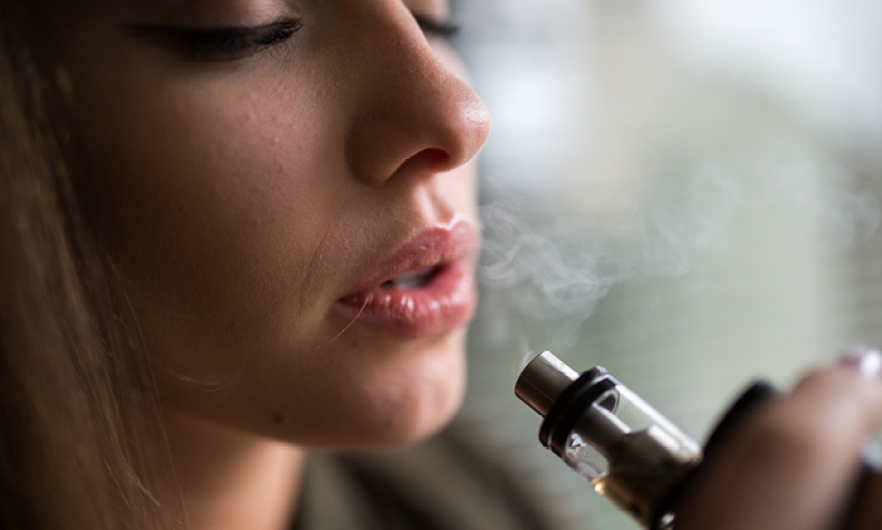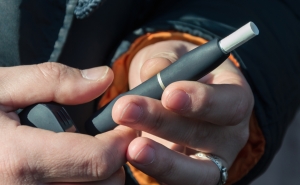Vaping Q&A: Johns Hopkins Expert on E-Cigarettes and Tobacco Alternatives

Last updated September 17, 2019
Vaping-related illnesses and deaths have drawn national attention since they first were documented last month. More than 380 confirmed and probable cases of lung disease and six deaths associated with e-cigarette use have been recorded in 36 states and the U.S. Virgin Islands as of September 11, according to the CDC.
The illnesses and deaths emphasize that there are risks associated with vaping, says Joanna Cohen, PhD, Bloomberg Professor of Disease Prevention and director of the Institute for Global Tobacco Control at the Johns Hopkins Bloomberg School of Public Health.
In this Q&A, Cohen shares her thoughts on myths behind vaping, what’s in e-liquids, how e-cigarettes are marketed to young people, and other issues.
What’s causing the sudden surge in illnesses and deaths related to vaping?
At this point, health authorities have not been able to identify what is causing the illnesses and deaths related to vaping. So far, there has not been one factor—like type of e-liquid, brand, where the vaping device and e-liquid were purchased, etc.—that has been common across all cases.
When will we know what’s behind the cause?
Hopefully very soon. The CDC and FDA are continuing to work around the clock to investigate what is causing these serious health problems.
How would people know if their vaping cartridges are safe?
Vaping is not safe.
The propylene glycol and/or vegetable glycerin that form the basis of e-liquids are generally regarded as safe for ingestion, but we do not yet know the effects when inhaled. The Surgeon General has concluded that nicotine in e-cigarettes can harm the developing brain. Little is known about inhaling flavor chemicals, but some ingredients used as flavorants are clearly harmful when inhaled. And there can be many other kinds of chemicals in the liquids people vape.
People have used vaping devices to vape other substances, including THC. There are no regulations yet on what the e-liquids contain, and there could be contaminants.
No one should be vaping unless they are a cigarette user trying to quit using cigarettes.
What’s your advice for people who used to smoke traditional cigarettes and have switched to vaping since it was supposed to be safer? Should they go back to tobacco?
The only group who should use vaping products are cigarette smokers who are trying to quit smoking, or former smokers who have successfully switched to vaping. If you fully switched and no longer smoke cigarettes, congratulations! Now, it’s important to try to get off vaping products as well because these products are not safe.
If you are in the midst of trying to quit smoking, do not go back to using cigarettes. However, you should monitor yourself for the symptoms associated with the outbreak related to e-cigarette use. The CDC has advice for the public.
Why are flavors in e-cigarettes being targeted for regulations?
Flavors are a focus of regulations because flavored products appeal to youth. Most youth who vape use a flavored product.
How has vaping been marketed to children and young people?
Youth have been exposed to a marketing for e-cigarette products through a range of channels, including social media/social influencers, product displays in stores, and ads outside of stores.
What laws on e-cigarette sales to young people exist?
The Public Health Law Center tracks e-cigarette laws at the state level. There are laws related to vendor licenses, product packaging, taxes, and sales to minors. Michigan recently announced that they are using an administrative rules process to ban the sale of flavored e-cigarettes unless and until they are authorized for sale by the FDA. Last year the city of San Francisco banned the sale of flavored e-cigarettes.
The FDA requires a warning on liquid nicotine. Last week the President indicated that unauthorized flavored e-cigarettes will have to come off the market, but no timelines are available yet. The Institute for Global Tobacco Control tracks e-cigarette policies at the country level.
What are some common myths/perceptions about vaping that are refuted by evidence?
One common myth is that vaping is safe. E-cigarettes have been available for just over 10 years, and there is evidence that these products can result in negative effects on our lungs, breathing, and cardiovascular system. E-cigarettes are NOT safe. Cigarettes are also not safe; in fact, they are extremely lethal. So if cigarette smokers have tried various approaches to quitting smoking, unsuccessfully, it is felt at this time that they can try to use e-cigarettes to help them quit cigarettes.
What should schools do about young people and vaping? Pediatricians? Parents?
No one other than cigarette smokers trying to quit smoking should be using e-cigarettes.
Schools should prohibit vaping … but realize that when they find a student who is vaping, that student needs their help to get off e-cigarettes. The same with parents and pediatricians. They should advise kids not to use e-cigarettes, and then provide help and support to quit if their child or patient is using these products.
What’s Big Tobacco’s role in e-cigarettes?
All major tobacco companies own e-cigarette brands. For example, Altria has a 35% stake in Juul. RJ Reynolds Vapor company is a subsidiary of RJ Reynolds American and markets the Vuse line of e-cigarette products.
For more information on vaping and tobacco issues:
Institute for Global Tobacco Control
The Facts About Electronic Cigarettes—CDC
RELATED
E-cigarettes, Juuls and Heat-Not-Burn Devices: The Science and Regulation of Vaping—Hopkins Bloomberg Public Health





